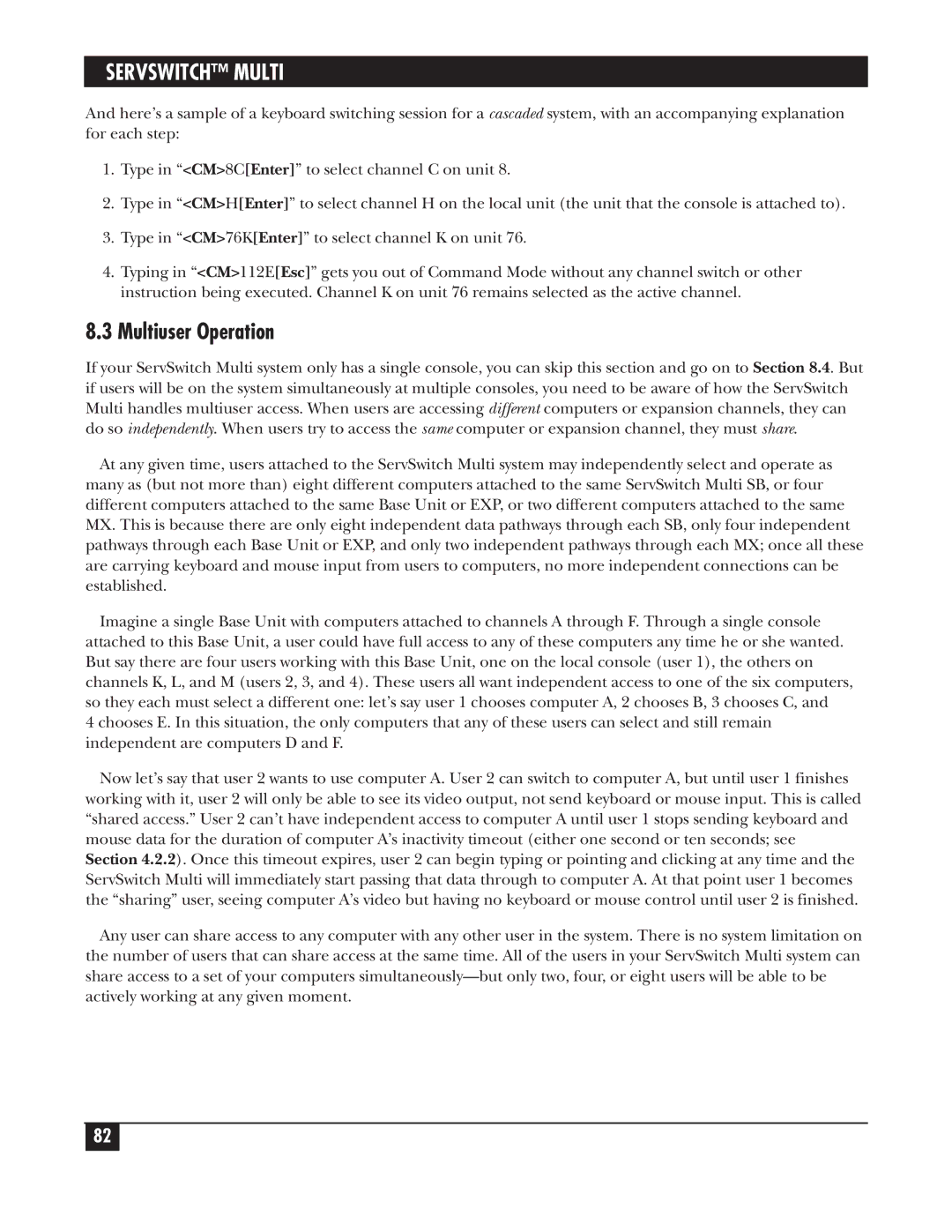
SERVSWITCH™ MULTI
And here’s a sample of a keyboard switching session for a cascaded system, with an accompanying explanation for each step:
1.Type in “<CM>8C[Enter]” to select channel C on unit 8.
2.Type in “<CM>H[Enter]” to select channel H on the local unit (the unit that the console is attached to).
3.Type in “<CM>76K[Enter]” to select channel K on unit 76.
4.Typing in “<CM>112E[Esc]” gets you out of Command Mode without any channel switch or other instruction being executed. Channel K on unit 76 remains selected as the active channel.
8.3Multiuser Operation
If your ServSwitch Multi system only has a single console, you can skip this section and go on to Section 8.4. But if users will be on the system simultaneously at multiple consoles, you need to be aware of how the ServSwitch Multi handles multiuser access. When users are accessing different computers or expansion channels, they can do so independently. When users try to access the same computer or expansion channel, they must share.
At any given time, users attached to the ServSwitch Multi system may independently select and operate as many as (but not more than) eight different computers attached to the same ServSwitch Multi SB, or four different computers attached to the same Base Unit or EXP, or two different computers attached to the same MX. This is because there are only eight independent data pathways through each SB, only four independent pathways through each Base Unit or EXP, and only two independent pathways through each MX; once all these are carrying keyboard and mouse input from users to computers, no more independent connections can be established.
Imagine a single Base Unit with computers attached to channels A through F. Through a single console attached to this Base Unit, a user could have full access to any of these computers any time he or she wanted. But say there are four users working with this Base Unit, one on the local console (user 1), the others on channels K, L, and M (users 2, 3, and 4). These users all want independent access to one of the six computers, so they each must select a different one: let’s say user 1 chooses computer A, 2 chooses B, 3 chooses C, and
4 chooses E. In this situation, the only computers that any of these users can select and still remain independent are computers D and F.
Now let’s say that user 2 wants to use computer A. User 2 can switch to computer A, but until user 1 finishes working with it, user 2 will only be able to see its video output, not send keyboard or mouse input. This is called “shared access.” User 2 can’t have independent access to computer A until user 1 stops sending keyboard and mouse data for the duration of computer A’s inactivity timeout (either one second or ten seconds; see Section 4.2.2). Once this timeout expires, user 2 can begin typing or pointing and clicking at any time and the ServSwitch Multi will immediately start passing that data through to computer A. At that point user 1 becomes the “sharing” user, seeing computer A’s video but having no keyboard or mouse control until user 2 is finished.
Any user can share access to any computer with any other user in the system. There is no system limitation on the number of users that can share access at the same time. All of the users in your ServSwitch Multi system can share access to a set of your computers
82
